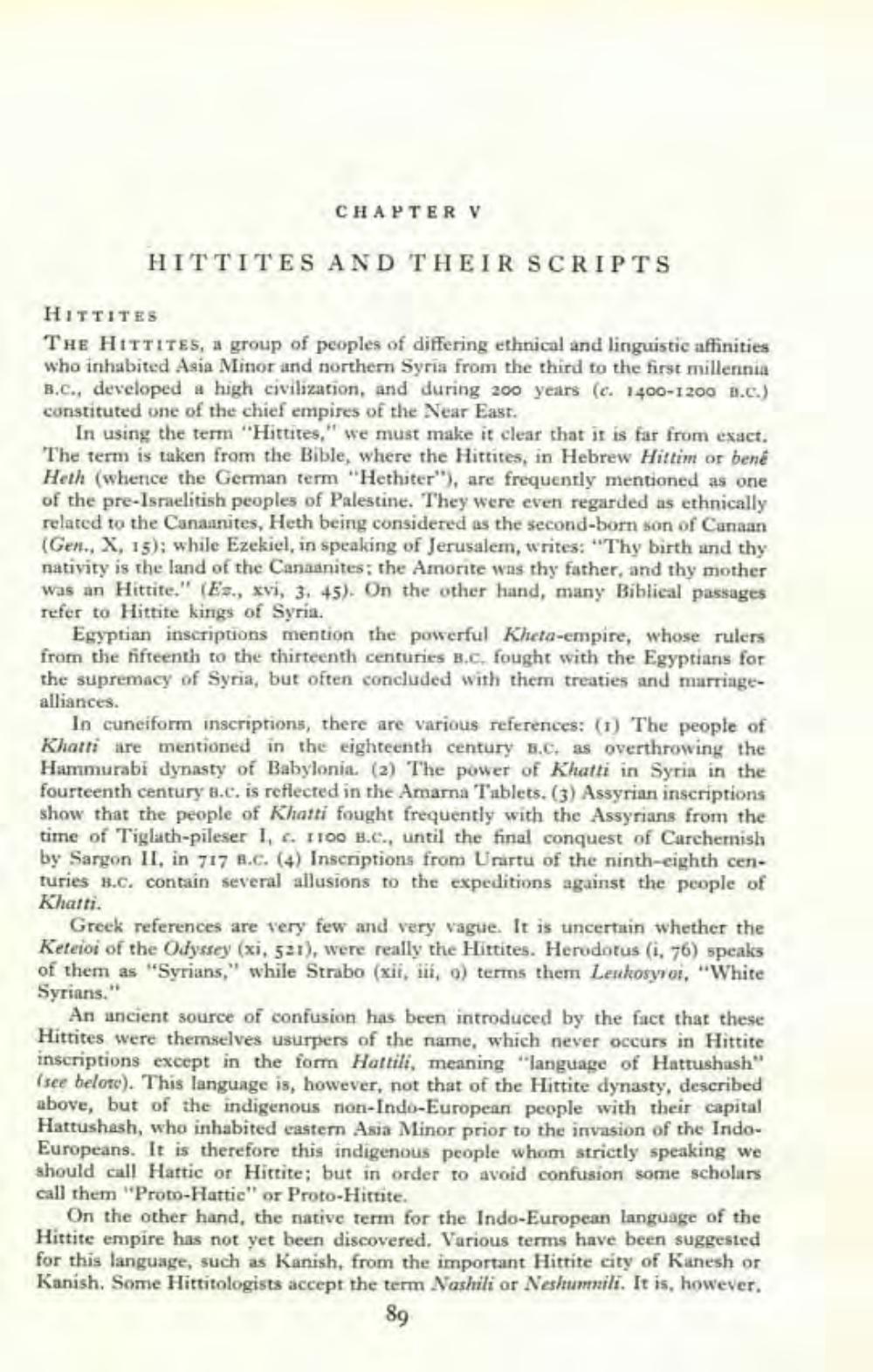________________
CHAPTER V
HITTITES AND THEIR SCRIPTS
HITTITES
THE HITTITES, a group of peoples of differing ethnical and linguistic affinities who inhabited Asia Minor and northern Syria from the third to the first millennia B.C., developed a high civilization, and during 200 years (c. 1400-1200 B.C.) constituted one of the chief empires of the Near East.
In using the term "Hittites," we must make it clear that it is far from exact. The term is taken from the Bible, where the Hittites, in Hebrew Hittim or bene Heth (whence the German term "Hethiter"), are frequently mentioned as one of the pre-Israelitish peoples of Palestine. They were even regarded as ethnically related to the Canaanites, Heth being considered as the second-born son of Canaan (Gen., X, 15); while Ezekiel, in speaking of Jerusalem, writes: "Thy birth and thy nativity is the land of the Canaanites; the Amorite was thy father, and thy mother was an Hittite." (Es., xvi, 3, 45). On the other hand, many Biblical passages refer to Hittite kings of Syria.
Egyptian inscriptions mention the powerful Kheta-empire, whose rulers from the fifteenth to the thirteenth centuries B.C. fought with the Egyptians for the supremacy of Syria, but often concluded with them treaties and marriagealliances.
In cuneiform inscriptions, there are various references: (1) The people of Khatti are mentioned in the eighteenth century B.c. as overthrowing the Hammurabi dynasty of Babylonia. (2) The power of Khatti in Syria in the fourteenth century 8.c. is reflected in the Amarna Tablets. (3) Assyrian inscriptions show that the people of Khatti fought frequently with the Assyrians from the time of Tiglath-pileser 1, c. 1100 B.C., until the final conquest of Carchemish by Sargon II, in 717 8.c. (4) Inscriptions from Urartu of the ninth-eighth centuries B.C. contain several allusions to the expeditions against the people of Khatti
Greek references are very few and very vague. It is uncertain whether the Keteioi of the Odyssey (xi, 521), were really the Hittites. Herodotus (i, 76) speaks of them as "Syrians," while Strabo (xii, iii, o) terms them Leukosyror, "White Syrians."
An ancient source of confusion has been introduced by the fact that these Hittites were themselves usurpers of the name, which never occurs in Hittite inscriptions except in the form Hattili, meaning "language of Hattushash" (see belote). This language is, however, not that of the Hittite dynasty, described above, but of the indigenous non-Indo-European people with their capital Hattushash, who inhabited eastern Asia Minor prior to the invasion of the IndoEuropeans. It is therefore this indigenous people whom strictly speaking we should call Hattic or Hittite; but in order to avoid confusion some scholars call them "Proto-Hattic" or Proto-Hittite.
On the other hand, the native term for the Indo-European language of the Hittite empire has not yet been discovered. Various terms have been suggested for this language, such as Kanish, from the important Hittite city of Kanesh or Kanish. Some Hittitologists accept the term Nashili or Neshumnili. It is, however,
89




